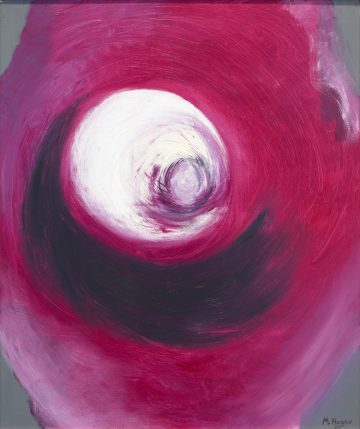Ogden Museum of Southern Art
925 Camp St
New Orleans, LA 70130
504.539.9650 | HOURS
925 Camp St
New Orleans, LA 70130
504.539.9650 | HOURS
Born: 1957, New Orleans, Louisiana
Died: 2003, New Orleans, Louisiana
Education: Oberlin Conservatory of Music, Ohio; Juilliard School of Music, New York and Louisiana State University, Louisiana

Moses Hogan, Turning Wheels, 1984, Oil on canvas, Gift of the artist and Roger H. Ogden
Moses Hogan was born in New Orleans, Louisiana on March 13, 1957. Moses manifested his musical talent at a young age. He anticipated the sound of church bells and guided his uncle Edwin Hogan’s choir by waving his hands as they sang. He was a graduate of the New Orleans Center for Creative Arts (NOCCA), Oberlin Conservatory of Music in Ohio and he also studied at New York’s Juilliard School of Music and Louisiana State University in Baton Rouge. Throughout his life, he created a number of new original arrangements of classic spirituals and formed several choirs such as the Moses Hogan Singers and the Moses Hogan Chorale. He also served as editor of the Oxford Book of Spirituals.
Hogan is considered the world’s greatest arranger of spiritual music. His contemporary settings of spirituals, original compositions and other works have been admired by audiences and commended by critics worldwide. His arrangements are still being used as the foundation for high school, college and university choirs today.
Moses Hogan was not an established visual artist. Painting was done at his leisure. In the late 1990s, he shared his painting with his friend, Roger H. Ogden. Roger’s response was, “Moses, is there any art form you don’t excel in?” As the Ogden Museum of Southern Art was being formed, Moses Hogan and Roger H. Ogden donated Turning Wheels to the Museum’s permanent collection.
Curator of the Collection Bradley Sumrall writes, “In Turning Wheels, Moses Hogan explores a symbol in paint that he had already deeply explored in music. Hogan’s arrangement of the spiritual, Ezekial Saw de Wheel, is perhaps his most celebrated work. Ezekial’s wheel is a symbol that resonated deeply with Africans that had been forced into slavery in America. It was a Christian version of the cosmogram, a core symbol of Kongo culture. With this painting, Hogan brings together his music, art, cultural history, complex identity and his belief system. It is a powerful painting from someone not widely known as a visual artist.”